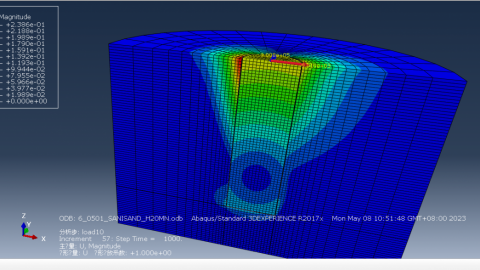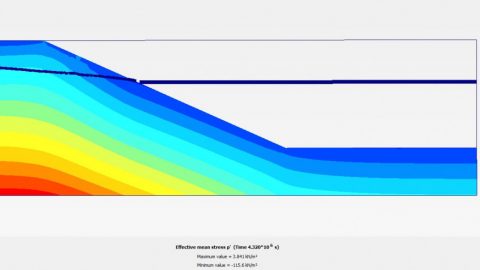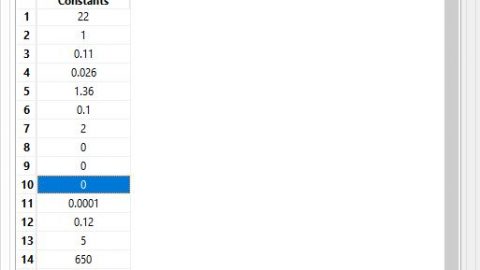I am modelling sand slopes in Plaxis 3D using an HP model. I am using soil parameters from “Modelling of Soil Behaviour with Hypoplasticity” by David Masin (2019). During the models the phreatic surface is rising. The problem I am having with my models are that the total displacement I get with the model is extremely small. A very loose slope with a height of 20 m only settles about 10 mm during gravity loading. I want to know if anyone has had similar problems and whether they know how to fix it?
Small displacements when using HP model in Plaxis 3D
Related Articles
-
An error in the SANISAND umat runtime
 Zhentao Liu||Finite Elements|15 |Views 1,848
Zhentao Liu||Finite Elements|15 |Views 1,848
Dear all I was simulating a pile in a fully drained soil subjected to horizontal loads using ABAQUS (as shown in Figure 1) and noticed from the monitor that the […] -
Plaxis 3D Tunnel
 Mesut Demir||Finite Elements|0 |Views 3,628
Mesut Demir||Finite Elements|0 |Views 3,628
Hi Everybody, I would like to ask an error problem where I am getting while using Plaxis 3D tunnel V 1.2. Previously I was using the software with Windows 7 […] -
Problem in simulating CPT using SANISAND04
 an zhanng||Finite Elements|5 |Views 1,445
an zhanng||Finite Elements|5 |Views 1,445
I have a question regarding the simulation of cone penetration tests using the SANISAND04 model. I have observed that the parameter m (yield surface size)has a significant impact on the […] -
Factor of safety in Plaxis 3D using hypoplastic model for sand
 Arno Crous||Finite Elements|1 |Views 3,820
Arno Crous||Finite Elements|1 |Views 3,820
I am currently modelling a test conducted in the geotechnical centrifuge facility at HKUST. The test consisted of a sand slope with a rising water table. The slope height in […] -
Problem in calculating Lateral displacement of the pile using Hypoplastic clay model
 arsalan Ahmad||Finite Elements|4 |Views 3,326
arsalan Ahmad||Finite Elements|4 |Views 3,326
Hy Professor David, I am trying to verify the result of one of your paper by the title ‘Cyclic lateral response and failure mechanisms of semi-rigid pile in soft clay: […] -
PM4Silt software
 Daniel Valencia||Finite Elements|5 |Views 3,435
Daniel Valencia||Finite Elements|5 |Views 3,435
Hello everybody, Does somebody know a FEM Software with the implementation of PM4Silt model’s routine? I mean, one different from FLAC. Thanks for your help. -
UMAT Implementation in Abaqus (Hypoplastic clay Subroutines)
 Lovinder Mann||Finite Elements|3 |Views 3,746
Lovinder Mann||Finite Elements|3 |Views 3,746
Hi, I am working in Abaqus, aiming to model double porosity clay consolidation data by using hypoplastic clay model with meta stable structure. First, i just wanted to verify basic […] -
FE formulation and software
 Mark G||Finite Elements|0 |Views 1,746
Mark G||Finite Elements|0 |Views 1,746
Hi, I am looking for advice on FE formulation and software. I am a recent graduate of MSc Geotechnical Engineering and am looking to do freelance work or possibly undertake […]
Search SoilModels Website
Recent posts
-
 Paper of Coulomb, C. A. (1773) 15.4.2024
Paper of Coulomb, C. A. (1773) 15.4.2024
-
 ABAQUS UMAT of hypoplastic clay model 6.4.2024
ABAQUS UMAT of hypoplastic clay model 6.4.2024
-
 Prague Geotechnical Days 2024 “Geotechnical monitoring” and 30th jubilee Prague Geotechnical Lecture by prof. Eduardo Alonso 5.4.2024
Prague Geotechnical Days 2024 “Geotechnical monitoring” and 30th jubilee Prague Geotechnical Lecture by prof. Eduardo Alonso 5.4.2024
-
 UMAT for Creep-SCLAY model. 1.3.2024
UMAT for Creep-SCLAY model. 1.3.2024
-
 Cyclic tests with Triax element test driver 14.2.2024
Cyclic tests with Triax element test driver 14.2.2024
-
 SUMMER SCHOOL ‘Numerical Modelling in Geotechnical Engineering’, Innsbruck – July 22nd-26th, 2024 1.2.2024
SUMMER SCHOOL ‘Numerical Modelling in Geotechnical Engineering’, Innsbruck – July 22nd-26th, 2024 1.2.2024
-
 COURSE IN SOIL MODELING – NTNU, Trondheim – October 14th to 18th, 2024 21.12.2023
COURSE IN SOIL MODELING – NTNU, Trondheim – October 14th to 18th, 2024 21.12.2023
-
 MSE walls design in Plaxis 11.12.2023
MSE walls design in Plaxis 11.12.2023
-
 sand liquefaction modelling in Anura3D 8.12.2023
sand liquefaction modelling in Anura3D 8.12.2023
-
 BCV bentonite experimental and modelling datasets 14.11.2023
BCV bentonite experimental and modelling datasets 14.11.2023
-
 Challenges in simulating geomechanical models using Mohr-Coulomb with Tension Cut-Off in Abaqus 20.10.2023
Challenges in simulating geomechanical models using Mohr-Coulomb with Tension Cut-Off in Abaqus 20.10.2023
-
 Analys soil liquefaction with Abaqus under blast load 19.10.2023
Analys soil liquefaction with Abaqus under blast load 19.10.2023
Recent Comments
- Gertraud Medicus on ABAQUS UMAT of hypoplastic clay model
- Chen Zhiming on Download Package of Charles University Implementation of High Cycle Accumulation Model
- Konstantinos Chatzis on Cyclic tests with Triax element test driver
- Abhay Pratap Singh on Cyclic tests with Triax element test driver
- Giovanni Ciardi on Cyclic tests with Triax element test driver
- Konstantinos Chatzis on Cyclic tests with Triax element test driver
- Ismail Khan on Cyclic tests with Triax element test driver
- Kanika Lamba on Cyclic tests with Triax element test driver
- Arie Koot on How to model the settlement in soil due to water drawdown.
- Konstantinos Chatzis on Cyclic tests with Triax element test driver
- Jose Duque on Cyclic tests with Triax element test driver
- MohamadReza Kamali on How to model the settlement in soil due to water drawdown.
- Leo Alibert on MSE walls design in Plaxis
- Ignacio Zuloaga on MSE walls design in Plaxis
- Giada Orlando on Problem with VUMAT interface
- Michael Spyridis on Problem with VUMAT interface
- Ahmad Moeineddin on Problem with VUMAT interface
- Nikolay Suyo Calla on Hardening soil Model UMAT






Hi Arno, it is really hard to grasp what you are doing from this information. There are various parameter sets in the book you cite, at least two hypoplastic models (clay, sand), with and without intergranular strain concept…?? You speak about water rising, but then that the problem is in gravity loading stages. So water probably does not play any role there? It is impossible to reply to question which is formulated this way…
I apologise, I should clarify the problem. The ultimate goal of my model is to back analyse centrifuge models conducted at the Hong Kong University of Science and Technology. The slope is a homogenous slope and I am using the Toyoura sand parameters from “Modelling of Soil Behaviour with Hypoplasticity”. In the tests the groundwater started rising. That part of the model works fine. However, the issue I am having is that from the beginning of the model (from the initial phase which is gravity loading) the displacements in the model is extremely small. I am getting only a few mm displacement in a slope that is 20 m high, irrespective of which phase I am calculating. I have tried changing boundary conditions and even using different soil parameters (i.e. Hochstetten and Karlsruhe sand). I have checked all the parameters and units multiple times and the model conditions as well. No matter what parameters or conditions I use, I keep getting extremely small displacements during all phases of my calculations. When I use other types of models such as the Mohr-Coulomb model, I do not have any of the issues with the small displacements.
Hi Arno,
First of all, please use parameters validated using Hong-Kong centrifuge simulations, for example from
Ng, C. W. W., Boonyarak, T. and Mašín, D. (2013). Three-dimensional centrifuge and numerical modeling of the interaction between perpendicularly crossing tunnels. Canadian Geotechnical Journal 50, No. 9, 935-946.
This is more specific than generic parameters from the book (calibrated long ago in Karlsruhe).
Then, please try to calculate with and without intergranular strain concept, to see if there is any difference (this will let us understand where the problem was initiated).
David
Hi David
I checked with the parameters from that journal paper. Without the intergranular strain concept I get a bit better displacements during gravity loading (about 0.4 m for a slope with a 20 m height). However, for the rest of the phases the displacements are still small.
When I activate the intergranular strain concept I get strange errors in the model during the initial phase. I get errors with both the displacement and stresses in general. Please find a link to some screenshots I took of the errors I get.
https://drive.google.com/open?id=1tZbnmXYu9LYZlqubX-1O6BoxbBe5_8al
Arno